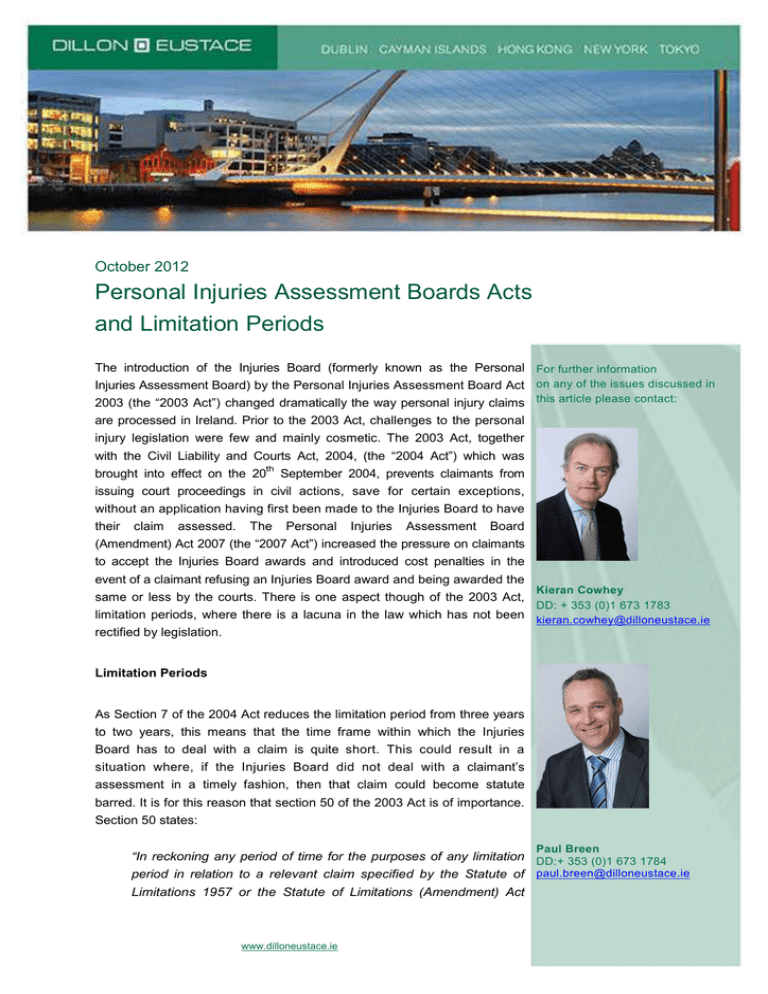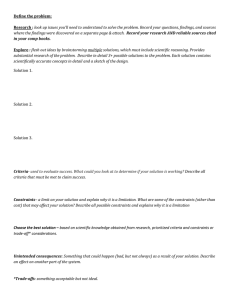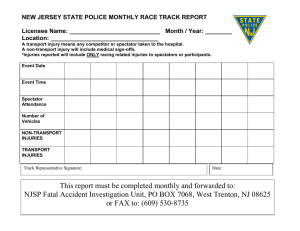
October 2012
Personal Injuries Assessment Boards Acts
and Limitation Periods
The introduction of the Injuries Board (formerly known as the Personal For further information
Injuries Assessment Board) by the Personal Injuries Assessment Board Act on any of the issues discussed in
2003 (the “2003 Act”) changed dramatically the way personal injury claims this article please contact:
are processed in Ireland. Prior to the 2003 Act, challenges to the personal
injury legislation were few and mainly cosmetic. The 2003 Act, together
with the Civil Liability and Courts Act, 2004, (the “2004 Act”) which was
th
brought into effect on the 20 September 2004, prevents claimants from
issuing court proceedings in civil actions, save for certain exceptions,
without an application having first been made to the Injuries Board to have
their claim assessed. The Personal Injuries Assessment Board
(Amendment) Act 2007 (the “2007 Act”) increased the pressure on claimants
to accept the Injuries Board awards and introduced cost penalties in the
event of a claimant refusing an Injuries Board award and being awarded the
Kieran Cowhey
same or less by the courts. There is one aspect though of the 2003 Act,
DD: + 353 (0)1 673 1783
limitation periods, where there is a lacuna in the law which has not been kieran.cowhey@dilloneustace.ie
rectified by legislation.
Limitation Periods
As Section 7 of the 2004 Act reduces the limitation period from three years
to two years, this means that the time frame within which the Injuries
Board has to deal with a claim is quite short. This could result in a
situation where, if the Injuries Board did not deal with a claimant’s
assessment in a timely fashion, then that claim could become statute
barred. It is for this reason that section 50 of the 2003 Act is of importance.
Section 50 states:
Paul Breen
“In reckoning any period of time for the purposes of any limitation DD:+ 353 (0)1 673 1784
period in relation to a relevant claim specified by the Statute of paul.breen@dilloneustace.ie
Limitations 1957 or the Statute of Limitations (Amendment) Act
www.dilloneustace.ie
1991, the period beginning on the making of an application under section
11 in relation to the claim and ending 6 months from the date of issue of
an authorisation under, as appropriate, section 14, 17, 32 or 36, rules
under section 46 (3) or section 49 shall be disregarded.”
The result of Section 50 is that once a claim is made to the Injuries Board the two year limitation period
imposed by the Statute of Limitations 1957 or the Statute of Limitations (Amendment) Act 1991
stops and does not recommence until six months after the authorisation has issued. An authorisation
is the document allowing the claimant to bring court proceedings in respect of his or her claim.
The issue here is that Section 50 only refers to limitation periods specified in the Statute of Limitations
Act 1957 (the “1957 Act”) and the Statute of Limitations (Amendment) Act 1991 (the “1991 Act”).
There are other types of personal injuries claims which have limitation regimes outside both of
these Acts.
Maritime Claims
The issuing of proceedings in personal injury cases arising out of any incident on a vessel is governed
by Section 46(2) of the Civil Liability Act, 1961 (the “1961 Act”). For most claimants’ solicitors
this is a little known limitation period. The limitation period is two years. Section 46(2) states:
“Where, by the sole or concurrent fault of a vessel damage is caused to that or another
vessel or to the cargo or any property on board either vessel, or loss of life or personal injury
is suffered, by any person on board either vessel, then, subject to subsection (3) of this
section, no action shall be maintainable to enforce a claim for damages or lien in respect of
such damage, loss of life or injury unless proceedings are commenced within two years from
the date when such damage, loss of life or injury was caused; and an action shall not be
maintainable to enforce any claim for contribution in respect of an overpaid proportion of any
damages for loss of life or personal injuries unless proceedings are commenced within one
year from the date of payment.”
When the general limitation period was three years practitioners tended to be more easily wrong
footed by this Section. The main point is that Section 50 of the 2003 Act does not specify the 1961 Act
when reckoning time for limitation purposes and maritime incidents resulting in personal injuries
claims fall outside the 2003 Act.
Aviation Claims
Aviation claims have always been governed by international conventions which in turn have been
given force of law by the Air Navigation and Transport Acts, as amended, and by EU Regulations.
The present regime is governed by the Montreal Convention 1999 (“the Convention”) and Council
th
Regulation (EC) No. 2027/97 of the 9 October 1997 (which essentially repeats the Convention as
amended by Regulation EC No. 889/2002).
www.dilloneustace.ie
Article 35 of the Convention states: “Limitation of actions:
1.
The right to damages shall be extinguished if an action is not brought within a period of two
years, reckoned from the date of arrival at the destination, or from the date on which the
aircraft ought to have arrived, or from the date on which the carriage stopped.
2.
The method of calculating that period shall be determined by the law of the court seized of
the case.”
Interestingly Article 35 states that the “right to damages shall be extinguished” if the action is not
brought within the two year period and this is more draconian then the normal limitation rules. Also
when claiming for damages arising out of international carriage by air, a claimant’s only cause of
action is under the Convention. The important issue here is that this limitation regime is separate
from the 1957 and 1991 Acts as specified in Section 50 of the 2003 Act.
Conclusion
It is quite clear that the two year limitation period imposed by the Statute of Limitations 1957 or
the Statute of Limitations (Amendment) Act 1991 by virtue of Section 50 of the 2003 Act does not
apply to two specific areas where personal injuries could arise. This appears to be a failing by the
draftsman. They are not areas where a large number of claims arise but claims do arise. The
Injuries Board have resolved the situation by not agreeing to assess any claims which are
submitted to them from these two areas (relying on Section 17 of the 2003 Act to do so) and issuing
an authorisation immediately. It is the practical application by the Injuries Board rather than the
legislature which has come to the rescue.
Dublin
33 Sir John Rogerson’s Quay, Dublin 2, Ireland. Tel: +353 1 667 0022 Fax: +353 1 667 0042.
Cayman Islands
Landmark Square, West Bay Road, PO Box 775, Grand Cayman KY1-9006, Cayman Islands. Tel: +1 345 949
0022 Fax: +1 345 945 0042.
Hong Kong
604 6F Printing House, 6 Duddell Street, Central, Hong Kong. Tel: +852 352 10352.
New York
245 Park Avenue, 39th Floor, New York, NY 10167, U.S.A. Tel: +1 212 792 4166 Fax: +1 212 792 4167.
Tokyo
12th Floor,Yurakucho Itocia Building, 2-7-1 Yurakucho, Chiyoda-ku, Tokyo 100-0006, Japan. Tel: +813 6860
4885 Fax: +813 6860 4501.
DISCLAIMER:
This document is for information purposes only and does not purport to represent legal advice. If you have any
queries or would like further information relating to any of the above matters, please refer to the contacts above
or your usual contact in Dillon Eustace.
Copyright Notice:
© 2012 Dillon Eustace. All rights reserved.
www.dilloneustace.ie




